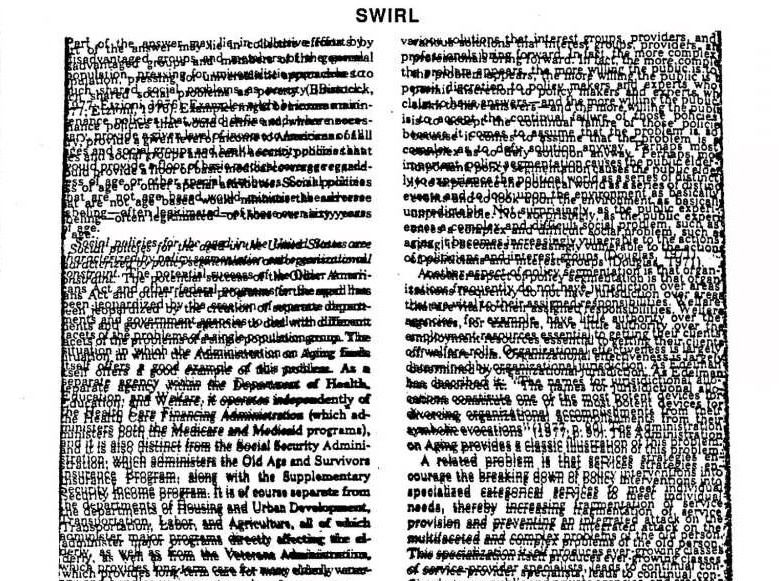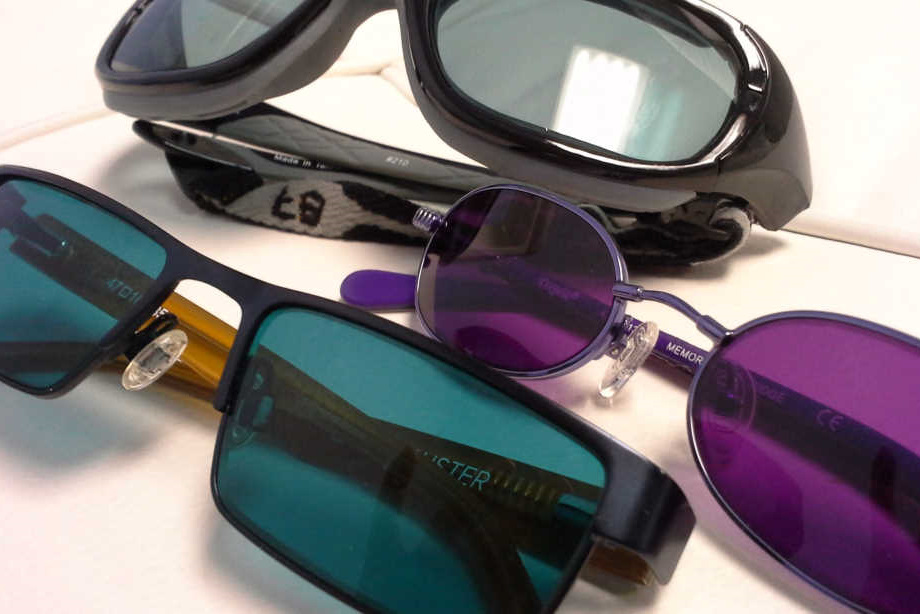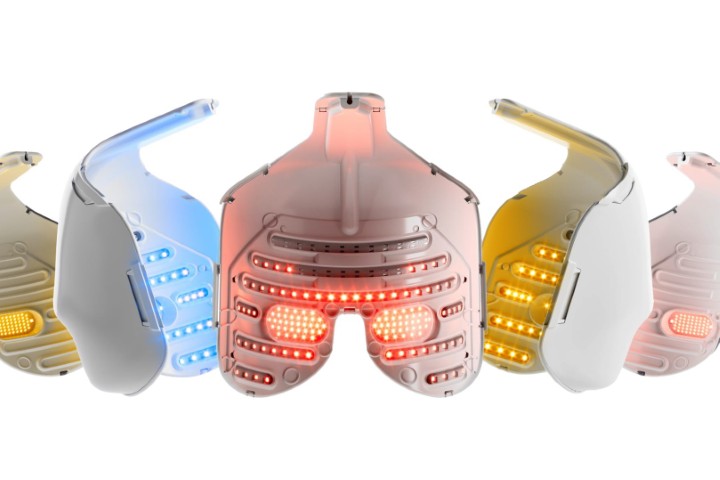Seeing vs perceiving
What every eye care practitioner should know about visual-perceptual processing problems.
In the world of optics, what an individual sees is of utmost importance and eye care professionals are impeccably trained to recognise and treat dysfunctions and anomalies related to the eye. The visual system, however, includes not just the eyes, but also the brain. Even when the eyes are functioning perfectly, the brain can have difficulty processing the visual information it receives. When this happens, what an individual “sees” can become like an optical illusion and a variety of difficulties ranging from reading problems to physical symptoms can result.

Swirled print distortion suffered by some people with visual perception processing problems
A common, but often mis- or unidentified condition
Since 1980, research has repeatedly documented the presence of, and difficulties associated with, a little known perceptual processing problem known as Irlen Syndrome. Irlen Syndrome is a problem with how the brain interprets visual information. The condition affects 12-14% of the general population and up to 46% of individuals with reading and learning difficulties. It is characterised by a variety of physical symptoms exacerbated by environmental factors such as lighting, especially bright lights and fluorescents, and computer screens, iPhones, white paper, white boards, high contrast and visually-intensive activities. Unfortunately, eye care professionals are unfamiliar with the warning signs of Irlen Syndrome. As a result, many individuals with this condition go unidentified and never receive proper intervention for their visual-perceptual processing problems.
Drs Ricardo and Marcia Guimaraes are ophthalmologists at the largest eye hospital in Brazil and researchers at the country’s second largest university. According to their research, the basic difference between the current optometric assessments and those required to identify visual-perceptual processing disorders is, “besides checking the static abilities granted by the parvocellular system and related to visual acuity (special resolution, refraction, intraocular pressure, biomicroscopy and fundoscopy, cover testing, OCT, etc.), it is necessary to also consider the performance of the eye under dynamic conditions.” Thus, the absence of a dynamic assessment protocol means Irlen Syndrome is not picked up during standard optometric exams.
How to tell if Irlen Syndrome might be part of the problem

Irlen specs: the coloured-lenses help with visual processing
Individuals with Irlen Syndrome will often complain of light sensitivity associated with sunlight, bright lighting, fluorescent lights, headlight and glare. They may also have reading problems, as reading becomes inefficient and they may need to re-read for comprehension or build breaks into reading. High contrast (black print on white paper) and visually-intensive activities, create high levels of stress for the brain that trigger physical symptoms which may include headaches and migraines. Brain imaging, both SPECT scans and fMRI, of individuals with this condition shows over-activity, complex brain patterns and non-normalised functioning. This results in a variety of issues, including difficulties reading because of a lack of print stability, issues with glare or discomfort from the white background on the printed page, problems with depth perception and physical symptoms, such as headaches, nausea, dizziness, brain fog, anxiety, strain and fatigue.
What we know about Irlen Syndrome
Over 100 scientific studies on the topic have established a hereditary component of the disorder1-3, a number of biochemical markers for problems associated with Irlen Syndrome4-6, and differences in brain function between individuals with and without the condition7-11. Precision-tinted colored filters have been found to normalise abnormal brain activity and eliminate issues with print clarity and stability, physical symptoms, and light sensitivity associated with the condition12-21. Although originally thought to be associated solely with reading problems, research has linked visual processing difficulties to a range of other disorders, including ADHD (attention deficit hyperactivity disorder), ASD (autism spectrum disorders), learning disabilities, anxiety and certain emotional and psychological issues22-24. Visual processing challenges also overlap with other neurological conditions, such as migraines and tourette’s8, 25.
Ongoing research by Drs. Adam Anderson and Eve De Rosa at Cornell University’s fMRI facility in the United States shows over-active brain function when Irlen Syndrome sufferers wear a blank lens that normalises when the proper precision-tinted colored filters are worn.
How eye care professionals can help: the need for comprehensive care
While binocular and accommodative anomalies may occur in conjunction with Irlen syndrome, they are not considered to be the underlying physiological basis of the condition 26-29. As such, comprehensive care of individuals suffering from Irlen Syndrome needs to include assessment and correction of eye-related dysfunctions and anomalies by an eye care professional before any assessment for Irlen Syndrome. Specific assessment and intervention for the neurologic dysfunction related to Irlen Syndrome ensures that both eye- and brain-related issues are being addressed.
A short pre-screening questionnaire can help identify individuals who might be at risk for Irlen Syndrome and most eye-care professionals can be trained to both identify and address Irlen Syndrome in their clients.
For more information about Irlen Syndrome, visit www.irlen.com, or contact Sarah Bycroft, the national director for Irlen NZ, on 09 414 4484 or sarah@irlen.nz.
References:
- Loew, S.J., & Watson, K. (2012). A prospective genetic marker of the visual perception disorder Meares–Irlen syndrome. Perceptual and Motor Skills, 114(3), 870-882.
- Robinson, G.L., Foreman, P.J., & Dear, K.G.B. (2000). The familial incidence of symptoms of Scotopic sensitivity/Irlen syndrome: comparison of referred and mass-screened groups. Perceptual and Motor Skills, 91, 707-724.
- Robinson, G.L., Foreman, P.J., Dear, K.G.B., and Sparkes, D. (2004). The Family Incidence of a Visual-Perceptual Subtype of Dyslexia. Nova Science Publishers, 27-40.
- Robinson, G.L., Roberts, T.K., McGregor, N.R., Dunstan, R.H., & Butt, H. (1999) . Understanding the causal mechanisms of visual processing problems: a possible biochemical basis for Irlen Syndrome? Australian Journal of Learning Disabilities, 4(4), 21-29.
- Robinson, G.L., McGregor, N.R., Roberts, T.K., Dunstan, R.H., & Butt, H. (2001). A biochemical analysis of people with chronic fatigue who have Irlen syndrome: speculation concerning immune system dysfunction. Perceptual and Motor Skills, 93, 486-504.
- Sparks, D.L., Robinson, G.L., Dunstan, H., & Roberts, T.K. (2003). Plasma cholesterol levels and Irlen Syndrome: preliminary study of 10- to 17-yr., old students. Perceptual and Motor Skills, 97, 745-752.
- Chouinard, B.D., Zhou, C.I., Hrybouski, S., Kim, E.S., Cummine, J. (2012). A functional neuroimaging case study of Meares-Irlen syndrome/visual stress (MISViS) Brain Topography, 25 (3), pp. 293-307.
- Huang, J., Zong, X., Wilkins, A., Jenkins, B., Bozoki, A., Cao, Y. (2011). fMRI evidence that precision ophthalmic tints reduce cortical hyperactivation in migraine. Cephalagia, 31(8):925-36.
- Lewine, J.D., Irlen, H.L., & Orrison, W.W. (1996). Visual evoked magnetic fields in Scotopic sensitivity syndrome. (Available from New Mexico Institute of Neuroimaging. The New Mexico Regional Field Medical Center: Albuquerque, NM).
- Riddell, P. M., Wilkins, A. and Hainline, L. (2006) The effect of colored lenses on the visual evoked response in children with visual stress. Optometry and Vision Science, 83 (5). pp. 299-305.
- Yellen, A. (2010). Irlen syndrome: a case study. Los Angeles Psychologist, May-June,16-18.
- Bouldoukian, J., Wilkins, A.J., & Evans, Bruce J.W. (2002). Randomised controlled trial of the effect of coloured overlays on the rate of reading of people with specific learning difficulties. Ophthalmological and Physiological Optics, 22, 55-60.
- IMAIZUMI, S., HIBINO, H., & KOYAMA, S. (2016). Effect of Colored Overlays on Reading Comfort in People with and without Meares-Irlen Syndrome. International Journal of Affective Engineering, 15(1), 21-28.
- Kim, J. H., Seo, H. J., Ha, S. G., & Kim, S. H. (2015). Functional Magnetic Resonance Imaging Findings in Meares-Irlen Syndrome: A Pilot Study. Korean Journal of Ophthalmology, 29(2), 121-125.
- Nobel, J., Orton, M., Irlen, S., & Robinson, G. (2004). A controlled field study of the use of coloured overlays on reading achievement. Australian Journal of Learning Disabilities, 9(2) 14-22.
- Park, S.H., Kim, S., Cho, Y.A., Joo, C. (2012). The Effect of Colored Filters in Patients with Meares-Irlen Syndrome. J Korean Ophthalmol Soc. 2012 Mar;53(3):452-459.
- Huang, J., Zong, X., Wilkins, A., Jenkins, B., Bozoki, A., Cao, Y. (2011). fMRI evidence that precision ophthalmic tints reduce cortical hyperactivation in migraine. Cephalagia, 31(8):925-36.
- Loew, S. J., Rodríguez, C., Marsh, N. V., Jones, G. L., Núñez, J. C., & Watson, K. (2015). Levels of Visual Stress in Proficient Readers: Effects of Spectral Filtering of Fluorescent Lighting on Reading Discomfort. The Spanish journal of psychology, 18, E58.
- Robinson, G.L., & Conway, R.N.F. (2000). Irlen lenses and adults: a small scale study of reading speed, accuracy, comprehension and self-image. Australian Journal of Learning Disabilities, 5, 4-13.
- Whiting, P., Robinson, G.L., & Parrot, C.F. (1994). Irlen coloured filters for reading: a six year follow up. Australian Journal of Remedial Education, 26, 13-19.
- Kim, J. H., Seo, H. J., Ha, S. G., & Kim, S. H. (2015). Functional Magnetic Resonance Imaging Findings in Meares-Irlen Syndrome: A Pilot Study. Korean Journal of Ophthalmology, 29(2), 121-125.
- Loew, S. J., & Watson, K. (2013). The prevalence of symptoms of scotopic sensitivity/Meares-Irlen syndrome in subjects diagnosed with ADHD: Does misdiagnosis play a significant role?. Hrvatska revija za rehabilitacijska istraživanja, 49(Supplement), 64-72.
- Irlen, H. (1991). Reading by the Colors. New York: Avery Press.
- Irlen, H. (2010) The Irlen Revolution: A Guide to Changing Your Perception and Your Life. New York: SquareOne Publishers.
- Ludlow, A. K., & Wilkins, A. J. (2016). Atypical Sensory behaviours in children with Tourette’s Syndrome and in children with Autism Spectrum Disorders. Research in Developmental Disabilities, 56, 108-116.
- Evans, B.J.W., Patel, R., Wilkins, A.J., Lightstone, A., Eperjesi, F., Speedwell, L., & Duffy, J. (1999). A review of the management of 323 consecutive patients seen in a specific learning disabilities clinic. Ophthalmological and Physiological Optics, 19(6), 454-466.
- Evans, B. J. W., Wilkins, A. J., Brown, J., Busby, A., Wingfield, A., Jeanes, R., & Bald, J. (1996). A preliminary investigation into the aetiology of Meares-Irlen syndrome. Ophthalmic and Physiological Optics, 16(4), 286-296.
- Evans, B. J. W., Wilkins, A. J., Busby, A., & Jeanes, R. (1996). Optometric characteristics of children with reading difficulties who report a benefit from coloured filters. In C. M. Dickinson, I. J., Murray, & D. Garden (Eds.), John Dalton's colour legacy (pp. 709-715). London : Taylor and Francis.
- Scott, L., McWhinnie, H., Taylor, L., Stevenson, N., Irons, P., Lewis E., Evans, M., Evans, B., & Wilkins, A. (2002). Coloured overlays in schools: orthoptic and optometric findings. Ophthalmological and Physiological Optics, 22, 156-165.
*Sandra Tosta, PhD, is head of research for the Perceptual Development Corporation at the Irlen Institute’s international headquarters. She holds a Bachelor of Science in Human Development from Cornell University and a PhD in Educational Psychology from the University of California, Los Angeles (UCLA). As a senior researcher at the Hypothesis Group for nearly a decade, she focused on research related to children and education. She has authored a variety of papers on Irlen Syndrome and related topics. For more information about the Irlen Institute and the Irlen Method, please visit www.irlen.com.


























